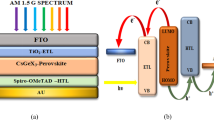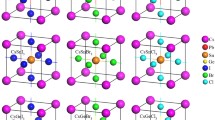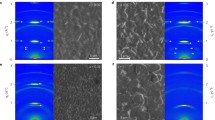Abstract
Recently, the solar energy sector has been greatly interested in lead (Pb)-free inorganic halide perovskites due to their remarkable mechanical, optical, electronic, and structural characteristics. Our study comprehensively assessed these attributes in cubic A3SbI3(A = Ba, Sr, Ca) perovskite materials via first principles density functional theory (FP-DFT) and SCAPS-1D simulation. These materials, similar to lead-free inorganic metal halide perovskites, demonstrated favorable tolerance factors, direct bandgaps, mechanical robustness, minimal losses, and high absorption coefficients. We aimed to explore how A-cation size influences their properties and solar cell performance, enabling effective comparisons. We systematically investigated novel A3SbI3-based structures with tin (IV) sulfide (SnS2) buffers, varying layer thickness, doping density, and defect density to evaluate photovoltaic (PV) capabilities. The Ba3SbI3 absorber exhibited the highest power conversion efficiency (PCE) at 30.26% with JSC of 44.24 mA/cm2, FF of 85.65%, and VOC of 0.80 V, while Sr3SbI3 and Ca3SbI3 absorbers achieved PCE of 26.93% and 20.87%, respectively, with corresponding JSC of 34.5 and 21.87 mA/cm2, FF of 86.90% and 85.85%, and VOC of 0.90 and 1.11 V. Our A3SbI3-based solar cell structures offer innovative alternatives to conventional designs.











Similar content being viewed by others
Data availability
All data and code are available in this link: https://doi.org/10.5281/zenodo.10562950.
References
Rahman F, Rahman H, Islam R, Hossain MK (2023) The optical and electronic properties of inorganic halide perovskite Sr3NCl3 under applied biaxial strain. J Mater Sci. https://doi.org/10.1007/s10853-023-08825-5
Feng HJ, Zhang Q (2021) Predicting efficiencies >25% A3MX3photovoltaic materials and Cu ion implantation modification. Appl Phys Lett. https://doi.org/10.1063/5.0039936
Owusu PA, Asumadu-Sarkodie S (2016) A review of renewable energy sources, sustainability issues and climate change mitigation. Cogent Eng. https://doi.org/10.1080/23311916.2016.1167990
Sharif A, Meo MS, Chowdhury MAF, Sohag K (2021) Role of solar energy in reducing ecological footprints: an empirical analysis. J Clean Prod. https://doi.org/10.1016/j.jclepro.2021.126028
Gong J, Darling SB, You F (2015) Perovskite photovoltaics: life-cycle assessment of energy and environmental impacts. Energy Environ Sci 8:1953–1968. https://doi.org/10.1039/c5ee00615e
Hossain J, Rahman M, Moon MMA et al (2020) Guidelines for a highly efficient CuI/n-Si heterojunction solar cell. Eng Res Express. https://doi.org/10.1088/2631-8695/abc56c
Rahman MF, Hossain J, Kuddus A et al (2020) A novel CdTe ink-assisted direct synthesis of CdTe thin films for the solution-processed CdTe solar cells. J Mater Sci 55:7715–7730. https://doi.org/10.1007/s10853-020-04578-7
Biplab SRI, Ali MH, Moon MMA et al (2019) Performance enhancement of CIGS-based solar cells by incorporating an ultrathin BaSi2 BSF layer. J Comput Electron. https://doi.org/10.1007/s10825-019-01433-0
Moon MMA, Rahman MF, Kamruzzaman M et al (2021) Unveiling the prospect of a novel chemical route for synthesizing solution-processed CdS/CdTe thin-film solar cells. Energy Rep 7:1742–1756. https://doi.org/10.1016/j.egyr.2021.03.031
Thomas JP, Leung KT (2014) Defect-minimized PEDOT:PSS/planar-si solar cell with very high efficiency. Adv Func Mater 24:4978–4985. https://doi.org/10.1002/adfm.201400380
Wilcoxon JP, Samara GA, Provencio PN (1999) Optical and electronic properties of Si nanoclusters synthesized in inverse micelles. Phys Rev B 60:2704–2714. https://doi.org/10.1103/PhysRevB.60.2704
Stranks SD, Eperon GE, Grancini G et al (2013) Electron-hole diffusion lengths exceeding 1 micrometer in an organometal trihalide perovskite absorber. Science 342:341–344. https://doi.org/10.1126/science.1243982
Cook TR, Dogutan DK, Reece SY et al (2010) Solar energy supply and storage for the legacy and nonlegacy worlds. Chem Rev 110:6474–6502. https://doi.org/10.1021/cr100246c
Yin W-J, Shi T, Yan Y (2014) Unique properties of halide perovskites as possible origins of the superior solar cell performance. Adv Mater 26:4653–4658. https://doi.org/10.1002/adma.201306281
Zhang W, Eperon GE, Snaith HJ (2016) Metal halide perovskites for energy applications. Nat Energy 1(6):1–8
Eperon GE, Stranks SD, Menelaou C et al (2014) Formamidinium lead trihalide: a broadly tunable perovskite for efficient planar heterojunction solar cells. Energy Environ Sci 7:982–988. https://doi.org/10.1039/c3ee43822h
Petrović M, Chellappan V, Ramakrishna S (2015) Perovskites: Solar cells & engineering applications—materials and device developments. Sol Energy 122:678–699. https://doi.org/10.1016/j.solener.2015.09.041
Kojima A, Teshima K, Shirai Y, Miyasaka T (2009) Organometal halide perovskites as visible-light sensitizers for photovoltaic cells. J Am Chem Soc 131:6050–6051. https://doi.org/10.1021/ja809598r
Hao F, Stoumpos CC, Cao DH et al (2014) Lead-free solid-state organic-inorganic halide perovskite solar cells. Nat Photon 8:489–494. https://doi.org/10.1038/nphoton.2014.82
Wang M, Wang W, Ma B et al (2021) Lead-free perovskite materials for solar cells. Nano-Micro Lett 13:62. https://doi.org/10.1007/s40820-020-00578-z
Niu S, Huyan H, Liu Y et al (2017) Bandgap control via structural and chemical tuning of transition metal perovskite chalcogenides. Adv Mater https://doi.org/10.1002/adma.201604733
Roknuzzaman M, Ostrikov K, Chandula Wasalathilake K et al (2018) Insight into lead-free organic-inorganic hybrid perovskites for photovoltaics and optoelectronics: A first-principles study. Org Electron 59:99–106. https://doi.org/10.1016/j.orgel.2018.04.051
Vasilev BC (2021) Enhancing the performance of a record—breaking perovskite. Silicon Tandem Solar Cell 1–8
Elqahtani ZM, Aman S, Mehmood S et al (2022) n-Type narrow band gap A3InAs3 (A = Sr and Eu) Zintl phase semiconductors for optoelectronic and thermoelectric applications. J Taibah Univ Sci 16:660–669. https://doi.org/10.1080/16583655.2022.2099200
Rahman MF, Rahman MA, Islam MR et al (2023) Unraveling the strain-induced and spin-orbit coupling effect of novel inorganic halide perovskites of Ca3AsI3 using DFT. AIP Adv https://doi.org/10.1063/5.0156961
Ghosh A, Rahman MF, Islam MR et al (2023) Structural, electronic and optical characteristics of inorganic novel cubic perovskite Sr3AsI3. Opt Contin https://doi.org/10.1364/optcon.495816
Rahman F, Islam M, Islam R et al (2023) An investigation on strain-incited electronic and optical properties of novel inorganic cubic material Sr3AsCl3. J Solid State Chem 328:124341. https://doi.org/10.1016/j.jssc.2023.124341
Rahman F (2023) Investigation of a novel inorganic cubic perovskite Ca 3 PI 3 with unique strain-driven optical, electronic, and mechanical properties. Nano Select. https://doi.org/10.1002/nano.202300066
Rahman F, Islam R, Ghosh A (2023) Exploring the impact of strain on the electronic and optical properties of inorganic novel cubic perovskite Sr3PI3. Phys Scr 98:115105. https://doi.org/10.1088/1402-4896/acfce9
Rahman MF, Rahman MH, Islam MR et al (2023) The optical and electronic properties of inorganic halide perovskite Sr3NCl3 under applied biaxial strain. J Mater Sci. https://doi.org/10.1007/s10853-023-08825-5
Rahman MF, Islam MAI, Islam MR et al (2023) Investigation of a novel inorganic cubic perovskite Ca3PI3 with unique strain-driven optical, electronic, and mechanical properties. Nano Select. https://doi.org/10.1002/nano.202300066
Ehrler B, Alarcón-Lladó E, Tabernig SW et al (2020) Photovoltaics reaching for the shockley-queisser limit. ACS Energy Lett 5:3029–3033. https://doi.org/10.1021/acsenergylett.0c01790
Islam MR, Islam ASMJ, Liu K et al (2022) Strain-induced tunability of the optoelectronic properties of inorganic lead iodide perovskites APbI3 (A= Rb and Cs). Phys B Condens Matter. https://doi.org/10.1016/j.physb.2022.413960
Qian J, Xu B, Tian W (2016) A comprehensive theoretical study of halide perovskites ABX3. Org Electron 37:61–73. https://doi.org/10.1016/j.orgel.2016.05.046
Pitriana P, Wungu TDK, Herman HR (2019) The characteristics of band structures and crystal binding in all-inorganic perovskite APbBr 3 studied by the first principle calculations using the density functional theory (DFT) method. Results Phys 15:102592. https://doi.org/10.1016/j.rinp.2019.102592
Islam R, Liu K, Wang Z et al (2022) Strain-induced electronic and optical properties of inorganic lead halide perovskites APbBr 3 (A= Rb and Cs). Mater Today Commun 31:103305. https://doi.org/10.1016/j.mtcomm.2022.103305
Fa HABIA, Perovskite C, Tailor NK et al (2021) Cation-dependent hot carrier cooling in the lead-free bismuth. J Phys Chem C. https://doi.org/10.1021/acs.jpcc.1c01509
Smith JM, Jones SP, White LD (1977) Rapid communication. Gastroenterology 72:193. https://doi.org/10.1016/S0016-5085(77)80340-5
Perdew JP, Burke K, Ernzerhof M (1996) Generalized gradient approximation made simple. Phys Rev Lett 77:3865–3868. https://doi.org/10.1103/PhysRevLett.77.3865
Giannozzi P, Baroni S, Bonini N et al (2009) QUANTUM ESPRESSO: a modular and open-source software project for quantum simulations of materials. J Phys Condens Matter 21:395502. https://doi.org/10.1088/0953-8984/21/39/395502
Perdew JP, Zunger A (1981) Self-interaction correction to density-functional approximations for many-electron systems. Phys Rev B 23:5048–5079. https://doi.org/10.1103/PhysRevB.23.5048
Hammer CL, Weber TA (1965) Time-dependent perturbation theory. J Math Phys 6:1591–1606. https://doi.org/10.1063/1.1704699
Langhoff PW, Epstein ST, Karplus M (1972) Aspects of time-dependent perturbation theory. Rev Mod Phys 44:602–644. https://doi.org/10.1103/RevModPhys.44.602
Ali MH, Al Mamun MA, Haque MD et al (2023) Performance enhancement of an MoS2-based heterojunction solar cell with an In2Te3 back surface field: a numerical simulation approach. ACS Omega 8:7017–7029. https://doi.org/10.1021/acsomega.2c07846
Burgelman M, Nollet P, Degrave S (2000) Modelling polycrystalline semiconductor solar cells. Thin Solid Films 361–362:527–532. https://doi.org/10.1016/S0040-6090(99)00825-1
Roknuzzaman M, Ostrikov K, Wang H et al (2017) Towards lead-free perovskite photovoltaics and optoelectronics by ab-initio simulations. Sci Rep 7:14025. https://doi.org/10.1038/s41598-017-13172-y
Rahman PhDMF, Harun-Or-Rashid M, Islam MR et al (2023) Exploring the impact of strain on the electronic and optical properties of inorganic novel cubic perovskite Sr3PI3. Phys Scr. https://doi.org/10.1088/1402-4896/acfce9
Tang TY, Zhao XH, Hu DY et al (2022) Theoretical exploration of mechanical, electronic structure and optical properties of aluminium based double halide perovskite. RSC Adv 12:10209–10218. https://doi.org/10.1039/d2ra01216b
Travis W, Glover ENK, Bronstein H et al (2016) On the application of the tolerance factor to inorganic and hybrid halide perovskites: a revised system. Chem Sci 7:4548–4556. https://doi.org/10.1039/c5sc04845a
Fu Y, Hautzinger MP, Luo Z et al (2019) Incorporating large a cations into lead iodide perovskite cages: relaxed goldschmidt tolerance factor and impact on exciton-phonon interaction. ACS Cent Sci 5:1377–1386. https://doi.org/10.1021/acscentsci.9b00367
Li C, Lu X, Ding W et al (2008) Formability of ABX 3 (X = F, Cl, Br, I) halide perovskites. Acta Crystallogr B 64:702–707. https://doi.org/10.1107/S0108768108032734
Hossain MK, Toki GFI, Kuddus A et al (2023) An extensive study on multiple ETL and HTL layers to design and simulation of high-performance lead-free CsSnCl3-based perovskite solar cells. Sci Rep 13:1–24. https://doi.org/10.1038/s41598-023-28506-2
Rubel MHK, Hossain MA, Hossain MK et al (2022) First-principles calculations to investigate structural, elastic, electronic, thermodynamic, and thermoelectric properties of CaPd3B4O12 (B = Ti, V) perovskites. Results Phys 42:105977. https://doi.org/10.1016/j.rinp.2022.105977
Rubel MHK, Mitro SK, Hossain MK et al (2022) First-principles calculations to investigate physical properties of single-cubic (Ba0.82K0.18)(Bi0.53Pb0.47)O3 novel perovskite superconductor. Mater Today Commun. https://doi.org/10.1016/j.mtcomm.2022.104302
Islam R, Rahman F, Bhattarai S et al (2023) Photovoltaic performance investigation of Cs3Bi2I9-based perovskite 2 solar cells with various charge transport channels using density 3 functional theory and one-dimensional solar cell capacitance 4 simulator frameworks. Energy Fuels. https://doi.org/10.1021/acs.energyfuels.3c00540
Hossain MK, Arnab AA, Das RC et al (2022) Combined DFT, SCAPS-1D, and wxAMPS frameworks for design optimization of efficient Cs2BiAgI6-based perovskite solar cells with different charge transport layers. RSC Adv 12:34850–34873. https://doi.org/10.1039/d2ra06734j
Hossain MK, Rubel MHK, Toki GFI et al (2022) Effect of various electron and hole transport layers on the performance of CsPbI3-based perovskite solar cells: a numerical investigation in DFT, SCAPS-1D, and wxAMPS frameworks. ACS Omega 7:43210–43230. https://doi.org/10.1021/acsomega.2c05912
Volonakis G, Haghighirad AA et al (2017) Cs2InAgCl6: a new lead-free halide double perovskite with direct band gap. J Phys Chem Lett 8(4):772–778
Noor NA, Iqbal MW, Zelai T et al (2021) Analysis of direct band gap A2ScInI6 (A=Rb, Cs) double perovskite halides using DFT approach for renewable energy devices. J Market Res 13:2491–2500. https://doi.org/10.1016/j.jmrt.2021.05.080
Nair S, Deshpande M, Shah V et al (2019) Cs 2 TlBiI 6: a new lead-free halide double perovskite with direct band gap. J Phys: Condens Matter 31:445902. https://doi.org/10.1088/1361-648X/ab32a5
Leijtens T, Bush KA, Prasanna R, McGehee MD (2018) Opportunities and challenges for tandem solar cells using metal halide perovskite semiconductors. Nat Energy 3:828–838
Pandey M, Jacobsen KW, Thygesen KS (2016) Band gap tuning and defect tolerance of atomically thin two-dimensional organic-inorganic halide perovskites. J Phys Chem Lett 7:4346–4352. https://doi.org/10.1021/acs.jpclett.6b01998
Xie Z, Hui L, Wang J et al (2018) Electronic and optical properties of monolayer black phosphorus induced by bi-axial strain. Comput Mater Sci 144:304–314. https://doi.org/10.1016/j.commatsci.2017.12.026
Kuzmenko AB (2005) Kramers-Kronig constrained variational analysis of optical spectra. Rev Sci Instrum 76:083108. https://doi.org/10.1063/1.1979470
Xu Z (1990) The determination of the momentum matrix elements involved in calculating the dielectric constants of superlattices using the tight-binding method. Solid State Commun 76:1143–1147. https://doi.org/10.1016/0038-1098(90)90981-G
Fadla MA, Bentria B, Dahame T, Benghia A (2020) First-principles investigation on the stability and material properties of all-inorganic cesium lead iodide perovskites CsPbI3 polymorphs. Phys B 585:412118. https://doi.org/10.1016/j.physb.2020.412118
Jong UG, Yu CJ, Kim YS et al (2018) First-principles study on the material properties of the inorganic perovskite Rb1-xCsxPbI3 for solar cell applications. Phys Rev B 98:32–39. https://doi.org/10.1103/PhysRevB.98.125116
Islam MN, Hadi MA, Podder J (2019) Influence of Ni doping in a lead-halide and a lead-free halide perovskites for optoelectronic applications. AIP Adv 9:1–9. https://doi.org/10.1063/1.5132985
Islam MR, Mojumder MRH, Moshwan R et al (2022) Strain-driven optical, electronic, and mechanical properties of inorganic halide Perovskite CsGeBr3. ECS J Solid State Sci Technol 11:033001. https://doi.org/10.1149/2162-8777/ac56c2
Born M (2013) Mathematical Proceedings of the Cambridge On the stability of crystal lattices. I. https://doi.org/10.1017/S0305004100017138
Lin C, Zhu M, Cao Z et al (2023) The influence of hydrogen on phase stability, mechanical and electronic properties of B2eZrCu compound from first-principles ScienceDirect ScienceDirect the influence of hydrogen on phase stability, mechanical and electronic properties of B2eZrCu comp. Int J Hydrog Energy. https://doi.org/10.1016/j.ijhydene.2023.07.138
Pugh SF (1954) XCII. Relations between the elastic moduli and the plastic properties of polycrystalline pure metals. Lond Edinb Dublin Philos Mag J Sci 45:823–843. https://doi.org/10.1080/14786440808520496
Pettifor DG (1992) Theoretical predictions of structure and related properties of intermetallics. Mater Sci Technol 8:345–349. https://doi.org/10.1179/mst.1992.8.4.345
Nb B, Ta B, Zhang Y et al (2023) Comparison of the physical properties and electronic structure of Nb2B3 and Ta2B3. Coatings. https://doi.org/10.3390/coatings13081302
Reza MS, Rahman MF, Kuddus A et al (2023) Boosting efficiency above 28% using effective charge transport layer with Sr3SbI3 based novel inorganic perovskite. RSC Adv 13:31330–31345. https://doi.org/10.1039/d3ra06137j
Haque MD, Ali MH, Rahman MF, Islam AZMT (2022) Numerical analysis for the efficiency enhancement of MoS2 solar cell: a simulation approach by SCAP-1D. Opt Mater 131:112678. https://doi.org/10.1016/j.optmat.2022.112678
Shah DK, Devendra KC, Kim T-G et al (2021) Influence of minority charge carrier lifetime and concentration on crystalline silicon solar cells based on double antireflection coating: a simulation study. Opt Mater 121:111500. https://doi.org/10.1016/j.optmat.2021.111500
Al ASR, Sunny A, Rahman S (2021) Performance enhancement of Sb2Se3 solar cell using a back surface field layer: a numerical simulation approach. Sol Energy Mater Sol Cells 221:110919. https://doi.org/10.1016/j.solmat.2020.110919
Monnaf A, Haque AKMM, Ali H et al (2023) Design and simulation of Cu2SnSe3-based solar cells using various hole transport layer (HTL) for performance ef fi ciency above 32%. Phys Scripta. https://doi.org/10.1088/1402-4896/ad0529
Moon MMA, Ali MH, Rahman MF et al (2020) Investigation of thin-film p -BaSi2/n-CdS heterostructure towards semiconducting silicide based high efficiency solar cell. Phys Scr 95:035506. https://doi.org/10.1088/1402-4896/ab49e8
Taheri S, Ahmadkhan Kordbacheh A, Minbashi M, Hajjiah A (2021) Effect of defects on high efficient perovskite solar cells. Opt Mater 111:110601. https://doi.org/10.1016/j.optmat.2020.110601
Rahman MF, Alam Moon MM, Hossain MK et al (2022) Concurrent investigation of antimony chalcogenide (Sb2Se3 and Sb2S3)-based solar cells with a potential WS2 electron transport layer. Heliyon 8:e12034. https://doi.org/10.1016/j.heliyon.2022.e12034
Acknowledgements
The authors extend their appreciation to the Deanship of Scientific Research at King Khalid University, Saudi Arabia, for funding this work through Research Groups Program under grant number R.G.P.2: 270/44.
Author information
Authors and Affiliations
Contributions
MFR involved in conception, experimental design, carrying out measurements, manuscript composition, methodology, software, Validation, formal analysis, visualization, investigation, data Curation, supervision, and writing—original draft. MHOR involved in experimental design, carrying out measurements, manuscript composition, data Curation, software, formal analysis, and writing—original draft. LBF, AB, MKAM, MAR, AAR involved in manuscript composition, software, formal analysis, and writing—original draft.
Corresponding author
Ethics declarations
Conflict of interest
All the authors have no conflict of interest.
Ethical approval
All the authors declare that the manuscript does not have studies on human subjects, human data or tissue, or animals.
Additional information
Handling Editor: Kevin Jones.
Publisher's Note
Springer Nature remains neutral with regard to jurisdictional claims in published maps and institutional affiliations.
Rights and permissions
Springer Nature or its licensor (e.g. a society or other partner) holds exclusive rights to this article under a publishing agreement with the author(s) or other rightsholder(s); author self-archiving of the accepted manuscript version of this article is solely governed by the terms of such publishing agreement and applicable law.
About this article
Cite this article
Harun-Or-Rashid, M., Farhat, L.B., Brahmia, A. et al. Analysis of the role of A-cations in lead-free A3SbI3 (A = Ba, Sr, Ca) perovskite solar cells. J Mater Sci 59, 6365–6385 (2024). https://doi.org/10.1007/s10853-024-09579-4
Received:
Accepted:
Published:
Issue Date:
DOI: https://doi.org/10.1007/s10853-024-09579-4




